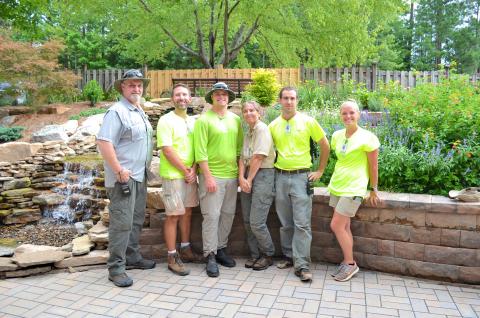Carol Woods Learning and Leisure Garden

October 23, 2019 -
Carol Woods has added a new feature to its campus. The Learning and Leisure Garden is now at the northeast corner of Building 4.
A waterfall and fountain provide soothing sound and movement. Raised planting beds are accessible to residents in wheelchairs. Gardeners can feel and smell the soil as they plant and whenever they return to see their plants grow. An arbor provides shade on hot summer days. There are easily negotiated paths and focal points, providing a safe environment for visitors with challenges.
The idea for this garden began, as so many do at Carol Woods, in the imagination of a few Residents. In the Fall of 2016, Eva Metzger and Pat Kiffney, along with family members, formed an interest group to upgrade the existing garden next to Building 4. Other members of the original group were Beth Schultz, Robin Holmes, Ali Little, and Barb DeLuca. The founders’ ideas took hold. Carol Woods management welcomed the possibility but needed to consider feasibility and to reconcile the cost of the project against other needs of the community. They wanted a commitment from the Health and Well Being Department that the garden would be used on a regular basis. Scott Lang, Manager of Landscaping and Grounds, participated in the discussions. He concluded that his team could build the project on a bigger and better scale than what was being planned, without recourse to outside contractors. And so they did.
A high priority was making it possible for residents with disabilities to get around the garden safely. For people in wheelchairs or walkers it can be remarkably difficult to get over thresholds and turn in tight spaces.
The entrance from Building 4 to the garden got lots of attention. Planning took advantage of local expertise. For example, Elizabeth Hart, an occupational therapist in the Rehabilitation Department, consulted on the project and actually got into a wheelchair to find out for herself how doors and ramps might be negotiated.
Planners took into account the typical decline in the senses with age. Aging eyes see saturated colors (such as orange, red, and yellow) better than blues, purple, and greens and that determined choice of plants, as did the wish to have color in all seasons. They chose plants that bring back memories, such as herbs, hydrangeas, azaleas, and roses. A range of senses is stimulated — the sound of falling water, the feel of soil, the smell of herbs and flowers.
Once a plan for the garden was agreed on, Scott and his team wanted to get started. They broke ground in March, 2018, but soon unusually heavy rainfall slowed progress. Mud at the worksite made it impossible to bring in heavy equipment to grade the site and move boulders into place. Finally, no longer willing to just wait for better weather, they erected a huge tarp tunnel over the worksite and were then able to carry on with the project rain or shine.
Materials were chosen carefully. Some of the large boulders that form the backbone of the waterfall were harvested from campus grounds. Flat surfaces at upper levels are of recycled materials which are softer to walk on, provide good traction, and let rainfall through. Treated lumber in earth tones support raised beds.
As promised, the garden has become a busy place. A Farmer’s Market meets there monthly. It used to be held in a parking lot! Growing Spirit, a program to plant, observe growth, and manage plants, meets there twice a month. The Building 5 walking group makes a rest stop there during their weekly strolls. A Learning and Leisure Interest Group meets there each Friday to discuss new ways the garden can be used. All residents are welcome. Building 4 activities — tea-time, music, exercise, and singalongs — are being moved to the garden. An underlying rationale is “therapeutic horticulture,” improving wellbeing through involvement with plants and gardening.
The garden is meant for visitors and all residents across the spectrum of care, not just for those in the higher levels of support. When passing by the garden, one often sees family visiting with each other by the waterfall or in the shade of the arbor. The staff dining area is next to the garden, so their work lives are enhanced as well.
The Learning and Leisure Garden is the signature outdoor space at Carol Woods. As Beth Schultz puts it, “With patience and mutual respect, residents and staff were able to work through challenges and accomplish the construction of a truly amazing garden.”
– Bob Fletcher, Chair of Landscaping and Grounds
